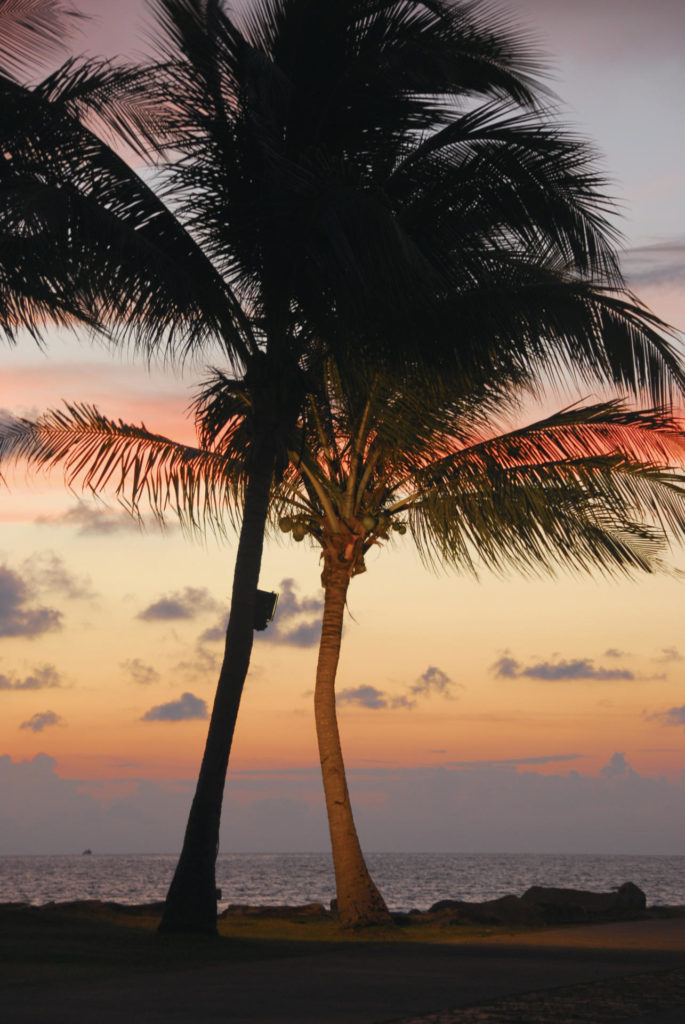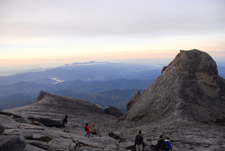What kind of traveler are you? Do you head to the beach with an ice-cold beer? Perhaps you prefer relieving stress on the hiking trails? Or do you like your adventure a stone’s throw from some of the finer things? Whatever your pleasure, Kota Kinabalu has a unique charm that is part vibrant young city, beach paradise and jungle utopia.

Kota Kinabalu (K.K., as it is affectionately known) was established on Malaysia’s eastern Borneo peninsula a little more than a hundred years ago. The resilient city has endured a few setbacks. It was completely torched by the native Bajaus, rebuilt to be razed again during World War II, leaving just three buildings standing. Yet, out of the ashes, K.K. rose again.
The natural beauty of its environs attracted tourists, while its prominent position as a port of commerce lured investors. A multitude of hotels, shopping centers, beach resorts and high-rise condos grew out of the rubble, and it’s still growing. Today the feel is of a compact, bustling metropolis with a touch of modern-chic.

K.K.’s geographic location makes it an appealing adventure destination. The city sits right between the glittering ocean and the ominous 4,000-meter peak of Mt. Kinabalu and the surrounding national park. Challenging outdoor activities and beach resort relaxation are within a stone’s throw of each other.
The Beach
Malaysia has some of the finest beaches in the world. Kota Kinabalu’s premier beach, Tanjung Aru, is two kilometers of white sandy beach and topaz water. Open food and drink stalls line the shore, adding some local flavor to the area, which features the five-star Shangri-La Beach Resort. The plush hotel has a wide variety of water sports and is located just six kilometers from the city center. You can hop in a taxi and be on the beach for around RM16.

The real fun is off the coast on the five magnificent islands that make up Tunku Abdul Rahman Marine Park. These are quite simply fabulous natural treasures; uninhabited drops of land with raw rainforest surrounded by strips of glittering beach, where you can come and go anytime.
Expensive resorts such as Tanjung Au or Sutera Harbor run ferries back and forth for objectionable prices; however, if you head yourself down to Kota Kinabalu Ferry Terminal, there are ferry operators running services for as little as RM10 one way. Alternatively, you can charter a boat for about RM240. Be prepared to wait, though, as there is no fixed schedule.
Once on island, you have a world of leisure stretching before you. Start on Manukan Island, as it has the most developed facilities, including several timber chalets, a clubhouse, bars and dive center. Superb swimming and barbecue pits are available, making it a perfect day out with friends. The water sports center has jet-skis for hire, or you can take windsurfing lessons.
Want to camp on the beach with the murmur of the ocean and sound of wind rustling through the trees? Head over to Sapi Island. Feel like ditching people and getting to some place more secluded? Hop over to Sulug, with its great swimming spots.
Mamutik Island is the place for diving. Lessons and rental gear are available. Overnight stays on Manukan Island are possible as well; however, consult your tour operator in advance, as chalet space is limited to 20 rooms.
The Mountain

Ninety kilometers from the city center sits Malaysia’s single World Heritage site, Kinabalu National Park. Spread over 750 square kilometers and towering higher than 4,000 meters, it is one of the most biologically diverse natural habitats in the world. The park covers a wide range of climates, from tropical conditions near sea level to dry, cold conditions at the summit.
This, combined with the unusual soil composition near the base of the mountain, makes Mt. Kinabalu and its surrounding areas home to truly diverse species of flora and fauna. They are critters here that can’t be found anywhere else in the world.
And while this is heaven for botanists and birdwatchers, let’s not forget the appeal the park has for trekkers and hikers. There are tens of kilometers of trails leading through lush rainforest and over steep ravine. After a day of hiking, rest those sore feet at the Poring hot springs, which you can get in free if you keep your entrance ticket stub (RM15 per adult).
With weeks of exploring at your disposal, it might be worth checking into one of the park’s lodges, and there are several options ranging from the lavish Rajah Lodge (from RM1,800 a night) to the modest but comfortable Grace Hostel (RM88 for a bed).

The real reason to visit Kinabalu National Park, though, and indeed K.K. in general, is the fabulous Mt. Kinabalu, thrusting up right through the center of the park. This exhilarating climb is generally accomplished over two legs with an overnight stay at the Laban Rata lodge at about 3,300 meters. The second day, you wake up at 2 a.m. to struggle up the last breathless 700 vertical meters to the summit (4,095 meters) to catch the spectacular sunrise over a sea of clouds.
Although the climb is considered easy, it is quite challenging for anyone of typical fitness, especially the second morning, which takes you over solid granite. There have been accidents on the mountain; people have wandered off the trail and gotten lost, so don’t expect a walk in the park.
 Warm clothing and flashlights are essential, as well as usual hiking equipment; however, no mountaineering equipment is required. The costs required to climb the mountain tend to mount up (pun intended), so here’s a breakdown of what you’ll need to pay: Climbing permit (RM100), climbing insurance (RM7), mountain guide (RM70) and accommodation at Laban Rata (from RM69 per bunk).
Warm clothing and flashlights are essential, as well as usual hiking equipment; however, no mountaineering equipment is required. The costs required to climb the mountain tend to mount up (pun intended), so here’s a breakdown of what you’ll need to pay: Climbing permit (RM100), climbing insurance (RM7), mountain guide (RM70) and accommodation at Laban Rata (from RM69 per bunk).
Most people usually come to the park through organized tours; however, it is possible to catch a cab all the way from downtown K.K. for about RM250. Ask around until you find one willing to take you there and haggle for a good price.
Essential Info
Getting there: Direct flights to Kota Kinabalu International Airport (BKI) are available from Tokyo and Osaka through Malaysian Airlines.
Currency: Malaysian Ringgit (RM). Exchange rate is roughly ¥33 to RM1.
Credit cards: MasterCard, VISA, American Express, Diners Club.
Climate: Equatorial, tropical, prone to heavy rain. January and February are generally the best times to go to avoid the rain.
Languages: Bahasa Malaysia, English and various dialects of Chinese (notably Hakka and Mandarin).
Electricity: 240 volts AC on 50 hertz.
Web Connection
Sabah Tourism: www.sabahtourism.com
Tourism Malaysia: www.tourism.gov.my




